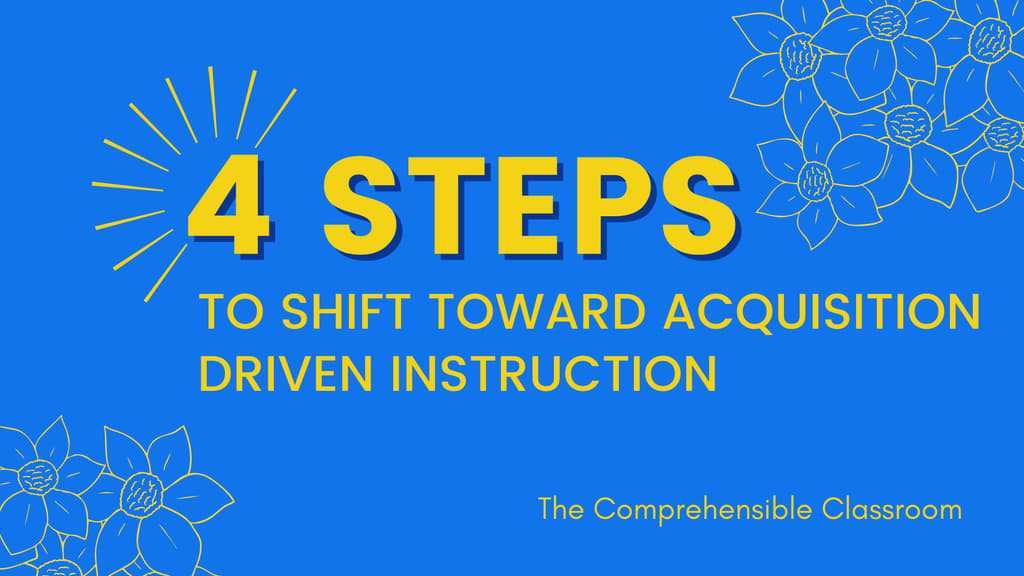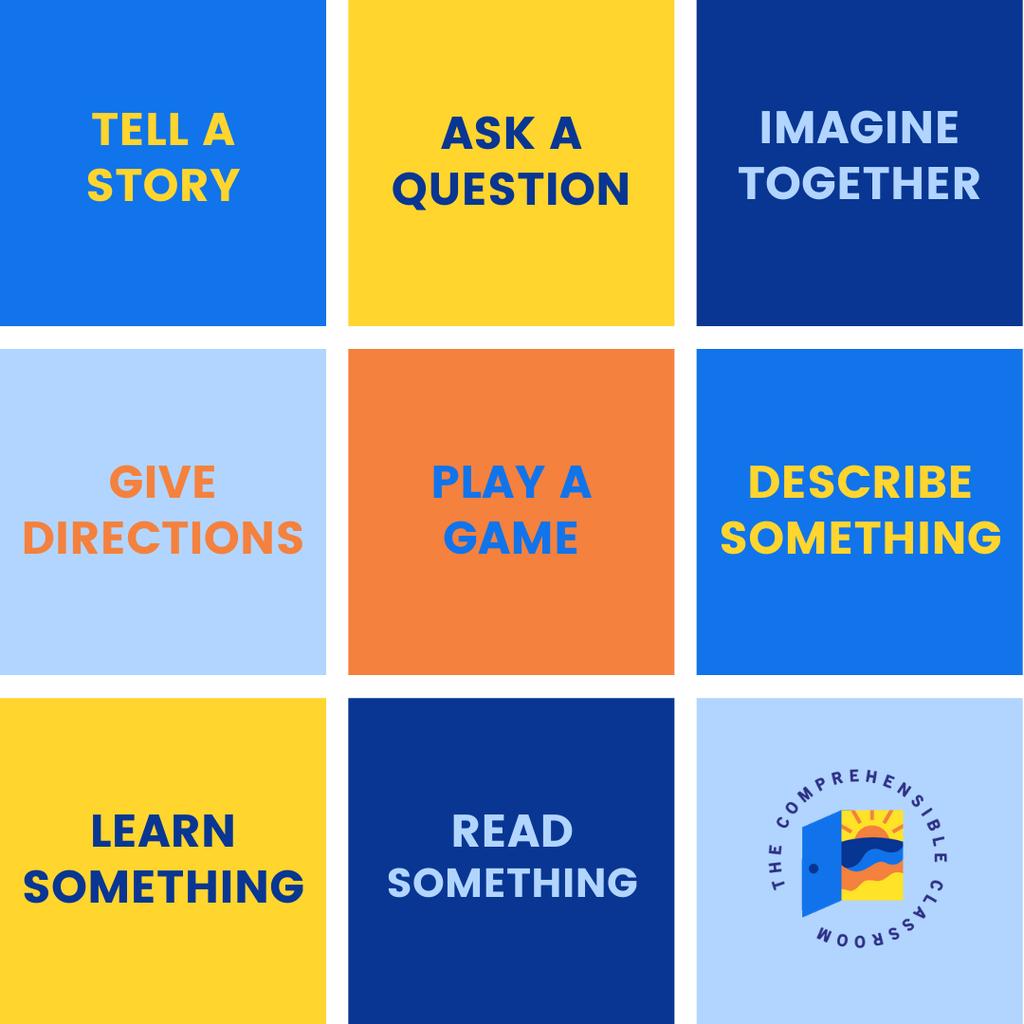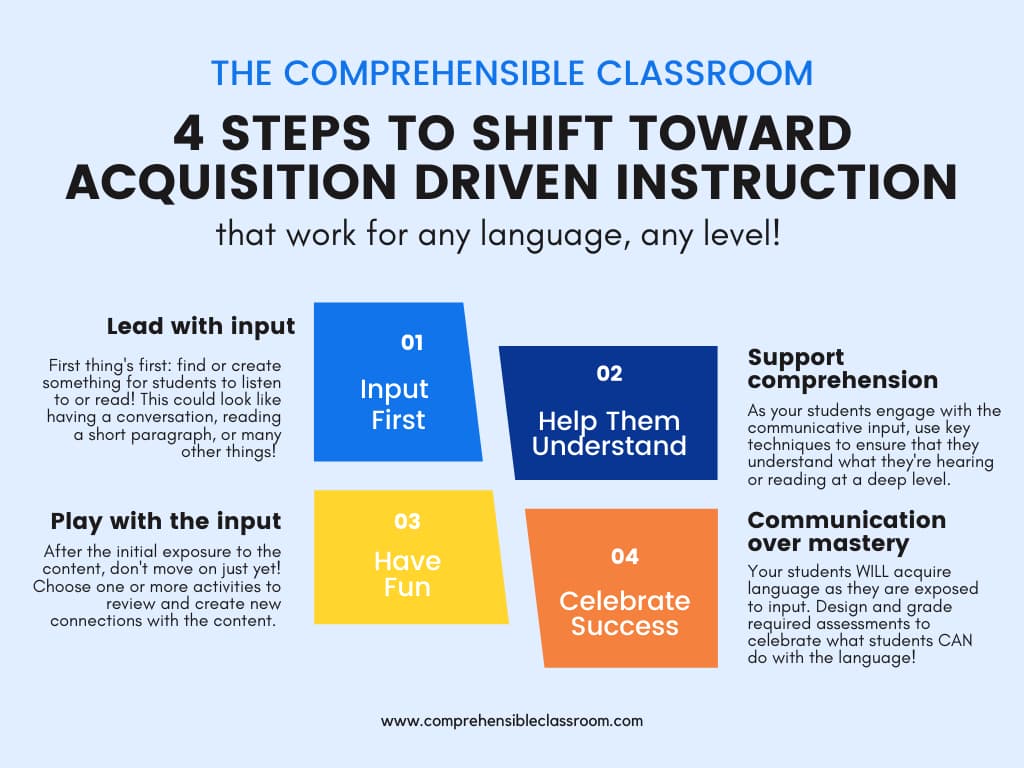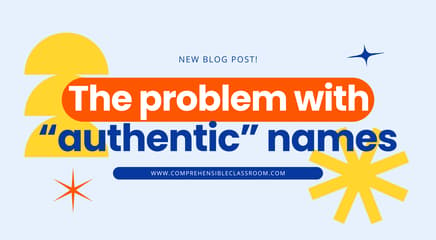If you are ready to move away from Explicit Language Instruction toward a more Implicit, Acquisition Driven Instructional model, you've come to the right place. Making this change is a complete paradigm shift, but it can be done in pieces. If you are ready to focus on helping your students to acquire language, as opposed to helping them learn about the language, there are four simple steps that you can take to move in that direction.

Step 1: Lead with input
First thing's first: find or create something for students to listen to or read! As learners are exposed to linguistic input that they can process, their amazing brains construct a mental representation of the target language in their heads. They are actually creating a version of the real-world language in their heads, based on the linguistic input that they were able to process. In order to build a linguistic system in their head that they can use to communicate, they must be exposed to contextualized language through communicative exchanges in your classroom.
Here are some of my favorite ways to load students up with linguistic input:
If you are working from an existing curriculum, look for ways to work these activities into the content that you are already teaching. For example, if you are teaching a unit on professions, do a Card Talk activity that focuses on the question, "What do you want to be in the future?". If you're doing a question about rooms in the home, ask a TPRS® story in which a character loses something and goes around the house looking for it. No matter what content you are teaching, you can find an input-focused activity to present it in a more acquisition-friendly way.

Step 2: Support comprehension
You may already be convinced that providing your students with linguistic input is critical to their success as language learners. Perhaps you are spending 90% or more of your class time in the target language, as ACTFL recommends! You are already on the right track, and there's one additional layer to bring in that will make your time in the target language well spent: supporting comprehension.
If your students do not understand the language that you're using in class, they can't acquire it. Just think about it: if someone is using a word over and over, and you do not understand that word, not only does it prevent you from understanding their message, but it prevents you from learning that word and using it in other communicative contexts. Acquisition cannot happen if comprehension does not occur (Bill VanPatten).
But what does it mean to understand something? To what extent must your students understand the input with which you are providing them in order to acquire it? Click here to see for yourself!
As your students engage with the communicative input, use key techniques to ensure that they understand what they're hearing or reading at a deep level. Doing so means that your instruction is indeed focused on acquisition because it is Comprehension-based: based on the premise that students must understand linguistic input in order to acquire it.
Step 3: Play with the input
After you just had so much fun enjoying a story together or learning about something super fascinating, no one will want to move on! Although it is not necessary to do activities, you will find that in many contexts there are reasons to spend time interacting with the language and the information from Step 2 by layering in some activities.
Giving students a second, third, or fourth exposure to the input will help their subconscious minds to make new linguistic connections each time, building and strengthening their mental representation of language. Considering the story or the information in different ways will also enrich students' understanding of the concepts and create new connections between students and the text, between peers in the class, and between students and the world outside the classroom.
Here are some of my favorite activities that can be used with any language and any level:
- Tic Tac Bingo: Students find answers to questions on a mini bingo board
- Before/After: Students consider what happened before or after named events
- Write and Discuss: The class co-creates a summary of the story or information
- Emotions analysis: Students reflect on what characters or individuals were feeling at certain points in their lives or stories
- Secret input reading: Students match hand-drawn images with lines from a familiar text
- Beep!: Students identify errors as the teacher retells the information
- Fan N Pick: Students work with unique roles in a group to complete an input-based task
- Write, Draw, Pass: Students attempt to interpret drawings and match them to a familiar text or content
Step 4: Celebrate success
The paradigm shift of acquisition-driven instruction is that, when it comes to language learning, what we teach isn't what students learn. Language acquisition is something that happens subconsciously, and no teacher on Earth can control what their students will acquire. Step 4 of the shift toward Acquisition Driven Instruction is beginning to let go of your expectations about what students "should" know or be able to do at any point in their language learning journey.
Now, as you begin this shift, start by trying to notice the different ways in which you are placing expectations on your students. Maybe your expectation is that students should be able to conjugate verbs in the present tense by the end of Year 1; maybe it is that they have memorized a set of words by the end of a given unit of instruction.
As you look at your own thinking and expectations, also begin to consciously ask yourself what each of your students CAN DO, right now, at this moment. Celebrate them where they are at, and trust that as you hone your skills and improve your ability to fill class time with interesting, processable input, your students will acquire what they are ready to acquire.
Here are some blog posts that are related to this critical step of celebrating success:
- What standards should I set for my language students?
- Mindset for Acquisition: Changes in instruction require changes in thinking
- Translating second language acquisition research into motivational practice
- “What ACTFL level is this text?”
- Crawling isn’t bad walking
- Develop assessments that support student success
- Easy midterms & finals for language classes

Get started
The most important step is the first one. If you are ready to take the first step, click here!




